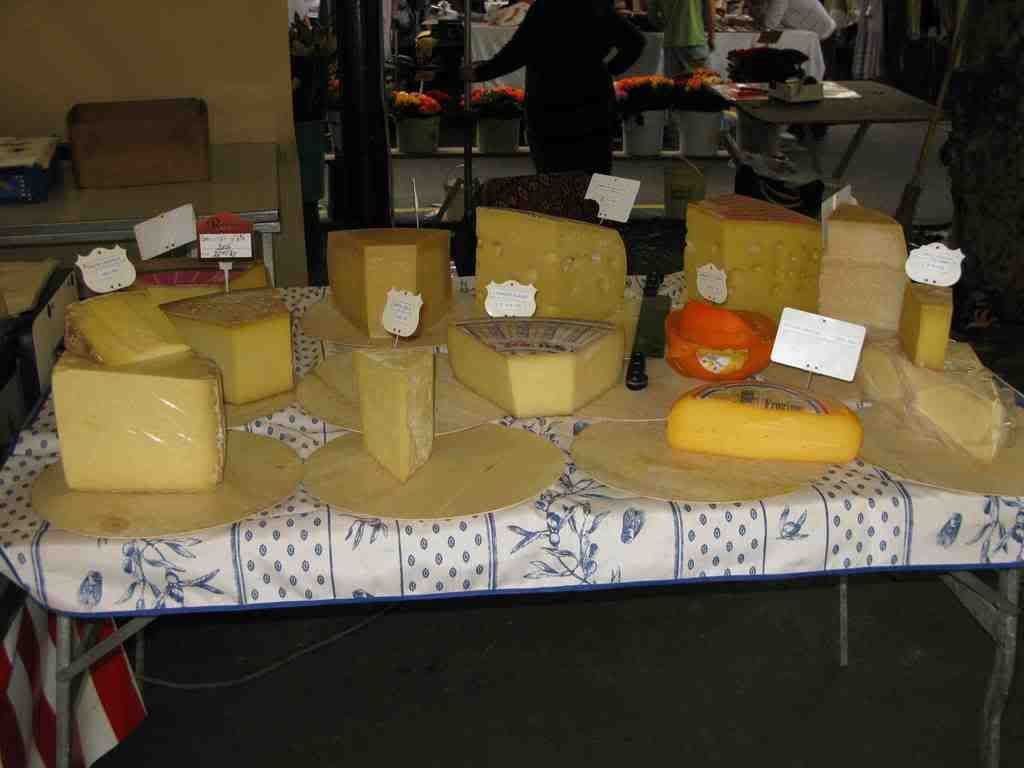 October 12, 2009
October 12, 2009The French take their cheese seriously, and frown on the North American practice of using pasteurized milk to make cheese. Indeed, European cheeses that wish to boast a "Protected Denomination of Origin" – the cheese equivalent of wine's "Appellation d'Origine Contrôlée" – must be manufactured from raw milk.
The US Food and Drug Administration permits the manufacture and marketing of hard cheese made from raw milk, if the cheese is aged at a temperature of at least 35ºF for no less than 60 days. Blue, brick and cheddar are a few of the cheeses that fall into this category.
Point Reyes Farmstead Cheese Company was just one of the raw milk-blue cheese producers on display at the San Francisco Farmer's Market during our visit last month. The company makes its cheese exclusively with milk from its own herd of Holsteins. The cheese-making process begins within a few hours after milking, and the cheese is allowed to age for six months – well beyond the 60 days required by FDA.
"But," you ask, "What about Listeria monocytogenes, Salmonella and E. coli? Is raw milk cheese as safe to eat as cheese made from pasteurized milk?"
VIAC offers Beginning and Advanced Cheesemaking Certificate programs, which include a course on Hygiene and Food Safety In Cheesemaking, and one on Risk Reduction Practices. The Institute also conducts ongoing research, including programs on Cheese Microbiology and Safety and Milk Quality.
Vermont and California are not the only states taking a hard look at hard cheeses made with raw milk. Maryland recently introduced a pilot program to encourage the production of raw milk cheeses on a few farms in the state. Pennsylvania, too, encourages an artisan cheese industry.
But don't expect FDA to expand its acceptance of raw milk cheeses beyond the hard cheese varieties. Recent research carried out by Dr. Donnelly and her University of Vermont colleagues showed that Listeria monocytogenes can grow on aged soft cheeses (e.g., Brie and Camembert). This is true regardless of whether the cheeses were made using pasteurized milk or raw milk.
Sticking to pasteurized milk for the production of soft cheeses reduces the risk of pathogens in the raw ingredients and, therefore, in the finished cheeses. Nevertheless, Listeria monocytogenes, which is found just about everywhere in the environment, can contaminate the cheese after it is made.
What does this mean for the consumer? Simply, anyone who is elderly, very young, pregnant, or suffers from a weakened immune system for any reason, should avoid eating soft cheeses – especially those made from raw milk. Hard cheeses that were made from fresh milk of high microbiological quality and held at 35ºF for 60 days or more, are far less likely than soft cheeses to support growth of bacterial pathogens.
The insertion of sound science into the cheesemaking process by organizations such as VIAC is good for both the dairy industry and the consumer. If we continue along this path, the United States will someday be able to rival its European cousins in the art and science of artisan cheesemaking. As you can see, we're already not doing too badly.
Some of the information contained in this article came from the following source:
D’Amico, D.J., M.J. Druart, and C.W. Donnelly. "60-Day Aging Requirement Does Not Ensure Safety of Surface-Mold-Ripened Soft Cheeses Manufactured from Raw or Pasteurized Milk When Listeria monocytogenes Is Introduced as a Postprocessing Contaminant" in Journal of Food Protection, vol 71(8): 1563–1571. 2008.





No comments:
Post a Comment
Note: Only a member of this blog may post a comment.